How To Use Logic App To Connect To Web Service
Azure Logic Apps Overview
This pillar page deals with features of Azure Logic Apps and how it can be managed and monitored with Serverless360. For a better agreement of Azure Logic Apps, let us consider a business scenario, FlyWheel Cab Booking Application. There are 2 main components in the awarding, the Vehicle Telematics awarding to collect existent-time data of the cabs to provide necessary information for booking. The Booking application to facilitate cab booking by customers. The booking application is congenital using Azure Serverless resources like Web App, Service Bus Queue and Topic, Logic App, and Azure Office which is of focus now. Below is the Service map illustrating how these Azure Services are integrated together past Azure Logic Apps.

Going forwards in this article we would focus on the Azure Logic App which defines the business workflow.
What is Azure Logic Apps?
Azure Logic Apps is a deject service. Using Logic Apps defines the workflow at ease consuming a range of APIs exposed equally Connectors. These Logic App connectors will perform the sequence of deportment defined in the workflow whenever the trigger gets fired.
Compare event-driven Azure Services
While choosing Azure Logic Apps to define the business concern workflow it is also necessary to gain noesis on other bachelor options. This section will throw light on the Azure offered alternatives to define a concern workflow.
Microsoft Period
Microsoft Menstruum is a Software as a Service offering from Microsoft Azure used to define the workflows using connectors and it doesn't need an Azure subscription to kickoff with. Though information technology is possible to define the workflow using Microsoft Menstruation for free, it has some limitations over Azure Logic Apps.
Microsoft Period does non support whatever Enterprise connectors, no governance and no Integration with Azure DevOps for CI/CD deployment.
In contrast, Azure Logic Apps exhibit support to a wide variety of services like action log for Governance, Enterprise connectors, Integration with Visual Studio and more.
Azure Durable Functions
Azure Durable Role is a Platform as a Service, offered past Azure with which users can define a piece of code to be executed on a trigger. Beneath are diverse types of triggers available for Azure Functions:
- Queue Trigger
- Timer Trigger
- Event Trigger
- Http Trigger
It is possible to define the workflow with Azure Durable functions. Durable role consists of Orchestrator, Orchestrator Customer and Activity Functions. Orchestrator Client will ship a request to Orchestrator which will define the workflow several Action Functions.
Though the Azure Durable Role supports defining workflow, user must write the custom code, which is time consuming whereas in Azure Logic Apps, at that place is no need for custom code, user tin can directly away define the workflow using predefined APIs available every bit connectors.
Next steps:
- Azure Logic Apps vs Microsoft Catamenia past Kent Weare
- Azure Logic Apps and Functions real-time comparison by Steef-Jan Wiggers
- Azure Logic Apps vs Durable Functions by Steef-Jan Wiggers
- Interesting Features in Azure Logic Apps
- What is API Apps and Logic Apps
Quick starts
With this understanding of Azure Logic Apps, lets straight away jump into some of the primal components of Logic Apps and understand how it works?
Workflows
Workflow in an Azure Logic App is a sequence of deportment or processes divers in steps. The actions will perform the business operations when input is provided through the managed connectors. Every workflow will be initiated by the trigger being fired. By defining the Workflow in Azure Logic Apps, Business processes can be automated and visualized in a bureaucracy. Below is the paradigm of the Azure Logic App workflow:
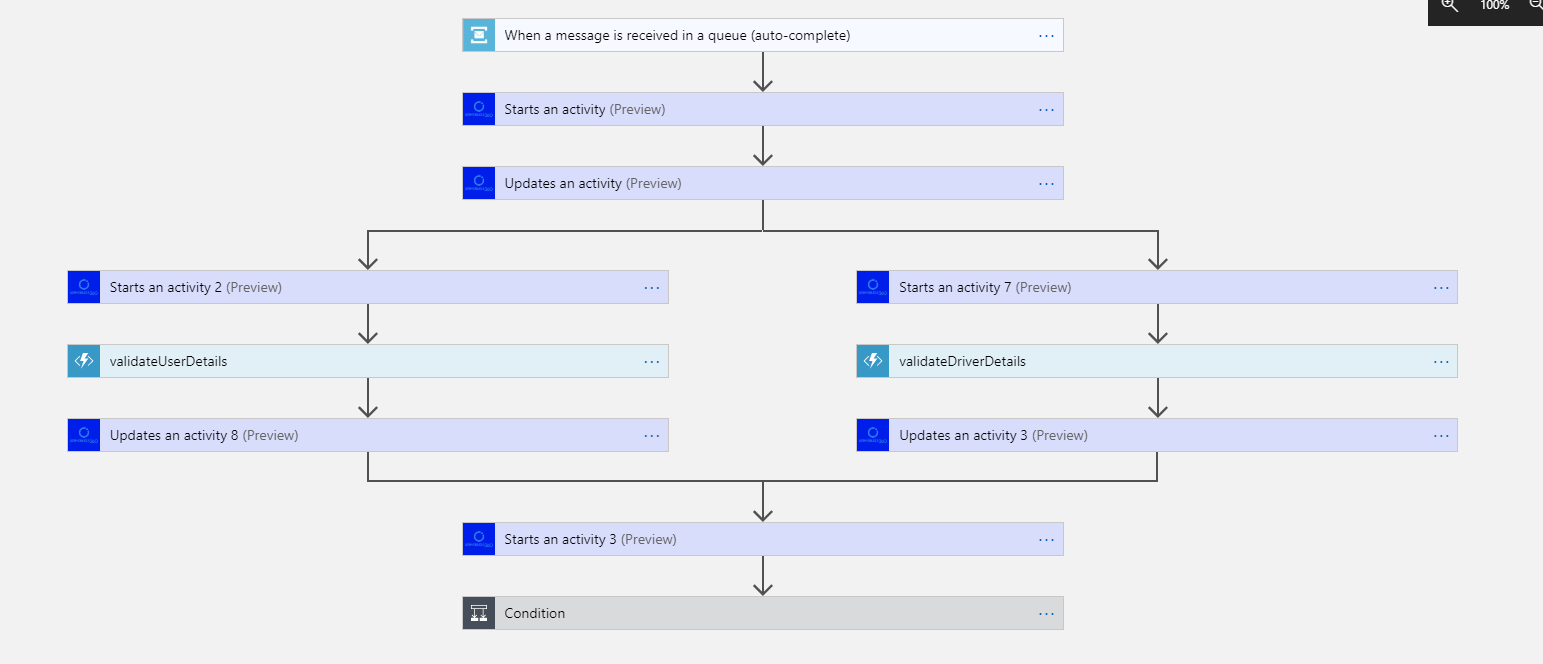
Managed Connectors
What are Logic App connectors?
Connectors in Azure Logic Apps are used to perform certain deportment or processes. These connectors are designed to connect and work with user data. There are numerous connectors available for Azure Logic Apps including Enterprise connectors. Users tin use pre-divers connectors as well as create their own custom connectors. Information technology is also possible to define connectors using ARM templates. Connectors in Azure Logic Apps may act either as actions or as triggers.
How do I add connectors to Logic App?
- Movement to the Azure portal and click on Create a resource.
- Enter Logic Apps Custom Connector in the search box and select it from the drop-down.
- In Logic Apps Custom Connector, select Create.
- Register the connector by providing the details and choose Review + create.
- Review the details entered and click on Create.
Later creating the custom connector resource, the carte opens automatically. If information technology doesn't, y'all can go to the subscription and resource group you selected and open it directly. With the custom connector in hand, you can define the connector'due south behaviour.
Actions
Actions are the steps those run once initiated by the trigger. Whenever a Azure Logic App gets triggered, there will be a succession of deportment those run to complete the workflow. Actions are processes those will perform the designated business job based on the data provided by the user. Users can select the required action from the extensive prepare of deportment bachelor in the connector repository.
Triggers
Triggers are the starting indicate for a Azure Logic App workflow that will fire when new data or event that meets the trigger condition occur. Connectors in Logic Apps itself provide diverse triggers. Custom triggers tin as well be created using custom connectors.
How practice you trigger a Logic App?
- Create a blank Logic App in the Azure Portal
- Select or search the trigger from the list given in the Logic App Designer
- Run a trigger in a saved Logic App by using the Run Trigger option in the overview section
Can a Logic App have multiple triggers?
Yes, multiple triggers can be divers in a Logic App. Multiple triggers can be accommodated in a Logic App workflow. As mentioned by Microsoft Azure, a single Logic App can have up to 10 triggers in it. In general, triggers are of ii types:
- Congenital-in triggers
- Managed API triggers
Built-in triggers are the predefined triggers using Http protocol and schedule for triggering the Azure Logic Apps. There are several Built-in trigger types similar HTTP, HTTP Endpoint, Recurrence, and Request.
Managed API triggers are based on the API connections / API Webhook connections which check an endpoint using custom connectors.
How to create API connexion in Azure Logic App?
- Select All services > Web > API Connections from the Azure portal menu.
- Select All resources from the Azure portal carte. The Type filter should be set to API Connectedness.
Let us further talk over the cosmos and working part of Azure Logic Apps.
How does Logic App work?
Azure Logic App works based on the workflow defined. Consider the Logic App in the Fly Wheel Cab Booking Application, defined with a trigger, Service Motorbus Trigger – "When a message is received in a queue", followed by a serial of actions. Now whenever the queue receives the message on a new booking, it will trigger the serial of actions to run and workflow to consummate.
The Values from one activeness will exist passed on to the subsequent action through the dynamic values. According to the Azure Logic App pricing model, the cost for a Logic App is based on the Number of Actions, triggers and runs executed.
Here are the basic operations of a Logic App:
How to create a Logic App?
The first step to beginning with a Logic App is to create one. Following are the steps to create a Logic App:
- In the Azure Portal, click on create a resource and select Logic Apps from the marketplace
- Click create to proceed
- Provide the basic credentials and click Review + Create
- Finally, click on Go to resource to navigate to the Logic App created.
How do I authenticate my Azure Logic App?
Based on where your logic app processes execute, Azure Logic Apps provides the organization-assigned managed identity, which you can use with only 1 logic app resource, and the user-assigned managed identity, which y'all may share across a drove of logic app resources.
- Open up your logic app resources in the Azure portal.
- Select Identity from the logic app'due south Settings menu.
- Select On > Salve in the Identity window under Organization assigned. When Azure asks if you want to ostend, say aye.
- The system-assigned identity, which is registered with Azure Advertizing and represented by an object ID, can now be used by your logic app resource.
How practice you phone call Azure Logic Apps?
Below are the steps to telephone call a Logic App from an existing Logic App
- Select New step > Add an activity under the pace where yous desire to invoke another logic app.
- Select Built-in from the drib-downwardly menu nether Choose an action. Enter logic apps as a filter in the search box. Choose a Logic Apps workflow from the activities list.
- Inside the existing logic app, nest a logic app.
- The designer displays the logic apps that are eligible for selection.
- Choose a logic app to call from the current logic app.
Side by side steps:
- Azure Logic Apps Custom Connectors by Kent Weare
- Azure Logic App Life Bike – The Big Picture by Steef-January Wiggers
- How to Call Deprecated Connector Actions on Logic Apps past Sandro Pereira
- Azure Logic App Expressions
Concepts
With an understanding of basic parameters of Azure Logic App, allow's bound on to the concepts those need to be considered when dealing with Azure Logic Apps.
Logic App state
The Azure Logic App can be in Enabled/Disabled state. User can modify the Logic App country from portal itself.
How practice I plow off Azure Logic App?
- In the Azure portal, open up your Logic App.
- Nether Logic App'due south menu select Overview and click on Disable option from the toolbar.
- To disable multiple Logic Apps, move into the Logic App section, bulk select and disable the Logic Apps.
When it comes to Logic App trigger and run, there are various states possible. Below are the basic states of the Logic App run:
- Succeeded – When the Logic Apps run/trigger is succeeded
- Running – When the Logic App run/trigger is Running
- Failed – When the Logic App run/trigger is Failed
- Skipped – When the Logic App run/trigger is Skipped
- Timed Out – When the Logic App run/trigger is Timed Out
With the diverse state of the Logic App, users can bank check the health of the Logic App.
How long can a logic app run?
The default run limit for synchronous actions in a multi-tenant Logic App is 120 seconds that is ii minutes.
How do yous troubleshoot Logic App?
Logic app generates data that tin can help you in diagnosing and debugging errors in the app. In Azure portal, you can diagnose a logic app by analysing each phase of the workflow.
- Check trigger history
- Check runs history
- Perform runtime debugging
Define workflow to meet business needs
Let us consider the Flywheel cab booking application, to define the Cab booking Scenario as a workflow using Azure Logic Apps. The client application will send the Booking message consisting of business data like User ID, Commuter ID, Location, Price and Destination to a Service motorcoach a queue. Now the requirement is to check whether the User ID and Driver ID is valid. Hither comes the Logic App with the service bus queue trigger – "When a message is received in queue". Now the Activity can be the invocation of Role apps which will check whether the User ID and Driver ID in the Service passenger vehicle message is valid or non. If Both User ID and Driver ID are valid, the Label of the Message will be set to true and the message volition be sent to Azure Service bus topic through Topic connector. At present whenever the Service bus queue receives the booking message, the message volition be validated and moved to Azure Service Bus Topic Subscription.
From the above Scenario, we can empathize how the Logic App works with diverse triggers and actions.
Sympathize Logic App metrics
Azure metrics give information on the condition of the resources in the Azure Subscription. With the all-encompassing set of metrics, user can find the wellness of the Azure Logic Apps. Metrics can also aid troubleshoot root-crusade of issues without needing to contact Azure support.
Action Metrics
These are the metrics related to Actions in the Logic App workflow
| Metric Name | Description | Monitoring Perspective |
|---|---|---|
| Action Latency | The average time taken between when an activity starts and ends Unit: Seconds | Performance |
| Actions Succeeded | The number of Actions succeeded in the Logic App runs in the given time Unit: Count | Availability |
| Actions Failed | The number of Actions failed in the Logic App runs in the given fourth dimension Unit: Count | Reliability |
| Action Skipped | The number of Deportment skipped in the Logic App runs in the given fourth dimension Unit: Count | Frequency |
| Billable Activeness Executions | The number of Actions that cost for the Execution Unit: Count | Consumption |
Run Metrics
These metrics are related to the runs of the workflow:
| Metric Proper name | Description | Monitoring Perspective |
|---|---|---|
| Run Latency | The average time taken between when a run starts and ends Unit: Seconds | Performance |
| Run Succeeded | The number of runs succeeded in the given fourth dimension Unit: Count | Availability |
| Run Failed | The number of runs failed in the given time Unit: Count | Reliability |
| Run Skipped | The number of runs skipped in the given fourth dimension Unit: Count | Frequency |
| Run Success Percentage | The number of successful runs divided by the total Unit: Count | Reliability |
Trigger Metrics
These metrics are related to the triggers of the workflow:
| Metric | Clarification | Monitoring Perspective |
|---|---|---|
| Trigger Fire Latency | The time taken for firing the trigger of the Logic app in the given time Unit: Seconds | Performance |
| Trigger Succeeded | The number of triggers succeeded in the given time Unit of measurement: Count | Availability |
| Trigger Failed | The number of triggers failed in the given time Unit of measurement: Count | Reliability |
| Trigger Skipped | The number of triggers skipped in the given fourth dimension Unit: Count | Frequency |
| Billable Trigger Execution | The number of Triggers that cost for the Execution Unit: Count | Consumption |
How do I debug Logic App?
When information technology comes to debugging the Azure Logic Apps, there volition be a need for triggers and run history to check if every activity has performed well. When there is any failure in at to the lowest degree one of the run actions, the whole run will be shown as the failure. Users can become into the failed run and debug the failure. Following are the steps to debug a Logic App:
- On the Logic App overview department, click on come across trigger history to bank check if any triggers have failed.
- Side by side, check for failed runs in the run history listed in the overview section.
- Click on the failed run and perform runtime debugging.
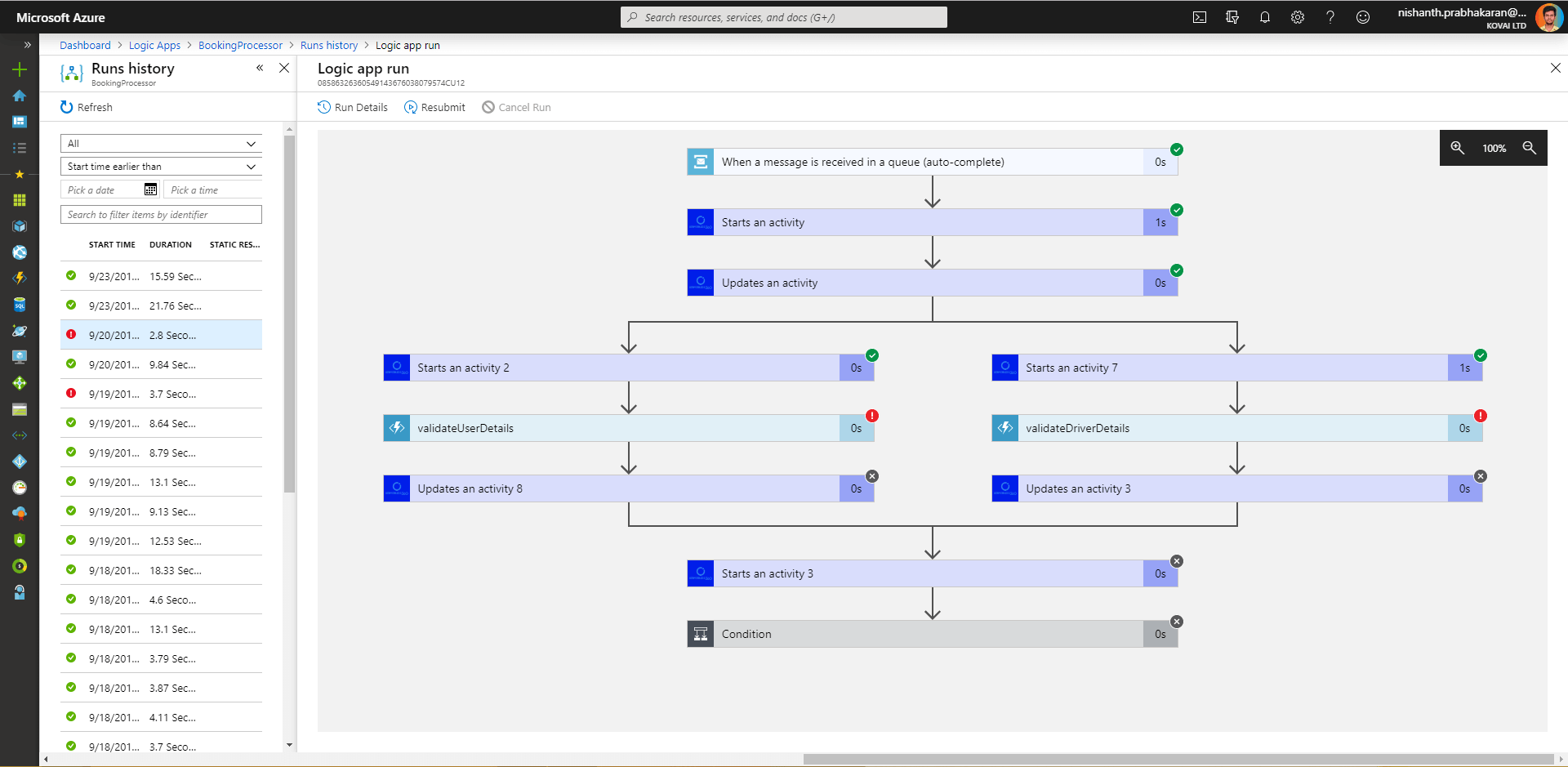
Azure Logic App pricing
Azure Logic App Pricing is completely based on executions of triggers, actions, and connectors.
- Deportment – $0.000025/ Exec
- Standard Connector – $0.000125/ Exec
- Enterprise Connector – $0.001/ Exec
For Integration Service Environs (ISE), the pricing counts on the base unit and scale unit. For Integration account with Logic App B2B, the pricing will vary based on the tiers
- Basic – $0.42/ 60 minutes
- Standard – $one.37/ Hr
What are the benefits of using Azure Logic Apps?
Azure Logic Apps have remarkable advantages which can solve various business concern challenges.
Below are some of the advantages of Azure Logic Apps
- Easy to ascertain the workflow – User can easily define the workflow with triggers and actions with user-intuitive GUI
- Support for Enterprise applications – Logic Apps support integration with Function 365, Twitter, Dropbox and more than
- Like shooting fish in a barrel debugging – User tin can easily debug the Logic App using Trigger and Run history
- Automation of workflow – By defining the workflow with triggers, it will automatically fire the Logic App when the trigger condition is succeeded
- Integration with on-premise solutions – Information technology is also possible to integrate the Logic App with on-premise solutions like BizTalk server, SAP and more
Logic App Integration Business relationship
Integration account with Logic Apps volition exist needed for Enterprise Integration and B2B solutions. By Integrating the Integration account with Logic Apps, user can store all the artefacts at i place, build B2B workflows, integrate with Third-political party SaaS applications and more than.
How do I secure my Azure Logic App?
Logic App ISE
Integration Service Surround (ISE) is where users can run their Logic App which can collaborate with the services every bit VMs secured inside the Azure Virtual Network. The Logic App and its storage will exist isolated from public Logic App services. Hence isolating the Azure Logic Apps will improve its performance too.
Sentiment Assay with Azure Logic Apps
Till now we got the light on Logic App Integration, Pricing, and Metrics. Now the focus will exist on some use cases like Sentiment Analysis with Azure Logic Apps. In this Sentimental Analysis, we will rank the tweets with the hashtag past using Logic Apps and other services. Whenever there is a tweet with some hashtag, the Azure Logic App will get triggered and with the assistance of Cognitive Service, it will score the tweet and store it into the blob storage and some of the score information volition be sent to Ability BI for analytics. Read more in detail on Sentimental Analysis with Azure Logic Apps
Azure Logic Apps with Mock Data
Some other use case nosotros can see is Apartment Customer Service built with Azure Logic Apps. In this scenario, the client wants to place a ticket to the customer support of the apartment about the maintenance work. Logic App will watch the ticket if the request by the customer is addressed. In one case the asking is addressed, it volition ship the postal service to the customer saying the work is completed. Read more on Testing Azure Logic Apps with Mock Information for the implementation of this Scenario.
Adjacent steps:
- Connecting Azure Logic Apps with Integration Account
- Azure Logic Apps – Integration Service Environment (ISE)
- Sentimental Analysis with Azure Logic Apps by Steef-January Wiggers
- Testing Azure Logic Apps with Mock Data by Kent Weare
Tools
By at present it is very articulate how powerful Azure Logic Apps are. The ease of addressing the business use cases using Logic App connectors makes them the best pick while building circuitous business orchestrations. However, managing and monitoring them in the Azure portal is not so uncomplicated and straight forward. This opens scope for tools to better manage and monitor Azure Logic Apps.
Log Analytics
Log Analytics is a tool to execute the Azure monitor Log Queries. By turning on the Log Analytics while creating the Logic App, user can perform monitoring and diagnostics logging for Azure Logic Apps. User can besides query the log for efficient debugging. By configuring the Log Analytics, user can get the complete view. East.g., number of actions failed, number of triggers failed and more than. Beneath are the detailed steps to enable Log Analytics for Azure Logic App:
How do I enable Log Analytics in Azure Logic App?
You tin can enable log analytics once you create your Logic App. Follow these steps on the Azure portal, where yous submit the details to create your logic app:
- Select On under Log Analytics.
- Select the workspace where you lot desire the information from your logic app to be sent from the Log Analytics workspace listing.
- After y'all consummate this step, Azure volition create your logic app, which will exist linked to your Log Analytics workspace. This step besides installs the Logic Apps Management solution in your workplace automatically.
- Select Create when you're finished.
How do yous check logs in Azure Logic App?
You may view the data from your logic app's runs in your Log Analytics workspace subsequently it has completed.
- Discover and open yourLog Analytics workspace via the Azure portal.
- SelectWorkspace summary > Logic Apps Management from the workspace menu.
- Select the row for a logic app or status to see all the runs for that logic app or status. You can too view tracked properties by clicking View in the Tracked Backdrop column for deportment where you put them up. Use the cavalcade filter to find the properties that take been tracked.
- Client-side and server-side filtering are both options for filtering your results.
- Client-side filter: Cull the filters you want for each column.
- Server-side filter: Utilize the scope command at the top of the page to select a certain fourth dimension window or to limit the number of runs that display. By default, merely 1,000 records are displayed at in one case.
- Select the row for a logic app run to see all the actions and their information for that run.
Next Steps:
- Insights using Log Analytics Author: Kent Weare
Serverless360
Azure Logic Apps solve huge business challenges with easy workflow pattern and automation just managing and monitoring the Azure Logic Apps in application context is not possible with Azure Portal. To solve this Claiming user must go ahead with Serverless360. Serverless360 is the solution for managing and monitoring Azure Serverless Applications. With the help of Serverless360, user can manage and monitor the Azure Logic Apps in the efficient way.
Serverless360 Vs Insights using Log Analytics
Since Application Insights is not bachelor for Azure Logic Apps, user can monitor the condition of the runs with a small work around using Log analytics and Logic App Direction. While creating the Azure Logic Apps, user need to enable the Log Analytics and workspace. Once the Logic App is created, user need to enable the Send to Log Analytics and configure the appropriate workspace in Diagnostics Settings. Now the user can monitor the runs in Logic App Direction workspace. With this work around, user tin can just track the status of the runs, actions and connectors.
Whereas with Serverless360, user can manage and monitor Azure Serverless resource as well equally with BAM in Serverless360, user can track the Business Process and the message flow through the orchestration. With Serverless360, user can monitor the Azure resources in various perspectives and it too has integration with Diverse Notification channels like
- Microsoft Teams
- Slack
- Pager Duty
- SMTP
- OMS
- Web Hook
- Service Now
Read here for more than on Serverless360 vs Application Insights
Serverless360 Vs Log Analytics
With Log Analytics, User tin can view the monitor logs on whether the run is succeeded or not, only it is not possible to monitor the state of every Actions and triggers. For this Challenge, user need to go with Serverless360 for monitoring Azure Logic Apps. In Serverless360, user can monitor the Operation, latency, Billable executions and more.
Adjacent Steps:
- Serverless360 vs Application Insights
Manage Azure Logic App in Serverless360
With Serverless360, user tin perform various remote deportment and operations on Azure Logic Apps with all deportment Governed and Audited and possible to monitor the Azure Logic Apps with extensive set of metrics
Change state
In Serverless360, the user can change the state of the entity similar Enable/Disable or run the triggers if there is a need to test the Azure Logic Apps. User tin also access the backdrop similar Resource Group Proper name, Region Name and Subscription Name of the Logic Apps.
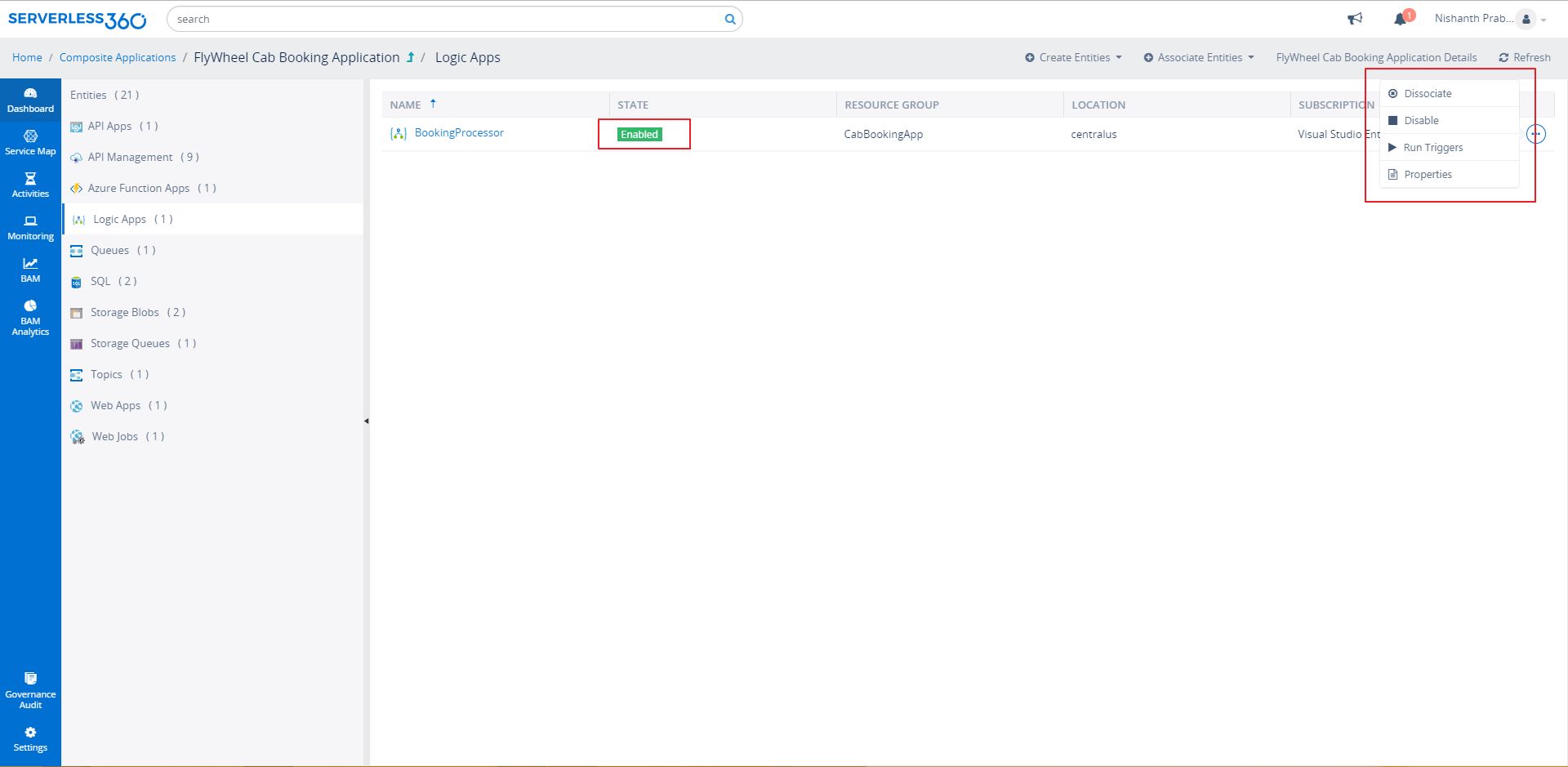
Access Trigger and run details
With the help of Serverless360, the user can access the trigger and run history. User can besides access the Input and Output bound of the Logic Apps triggers and Run Actions. This would be of swell help for DevOps engineers to investigate why a run action failed?
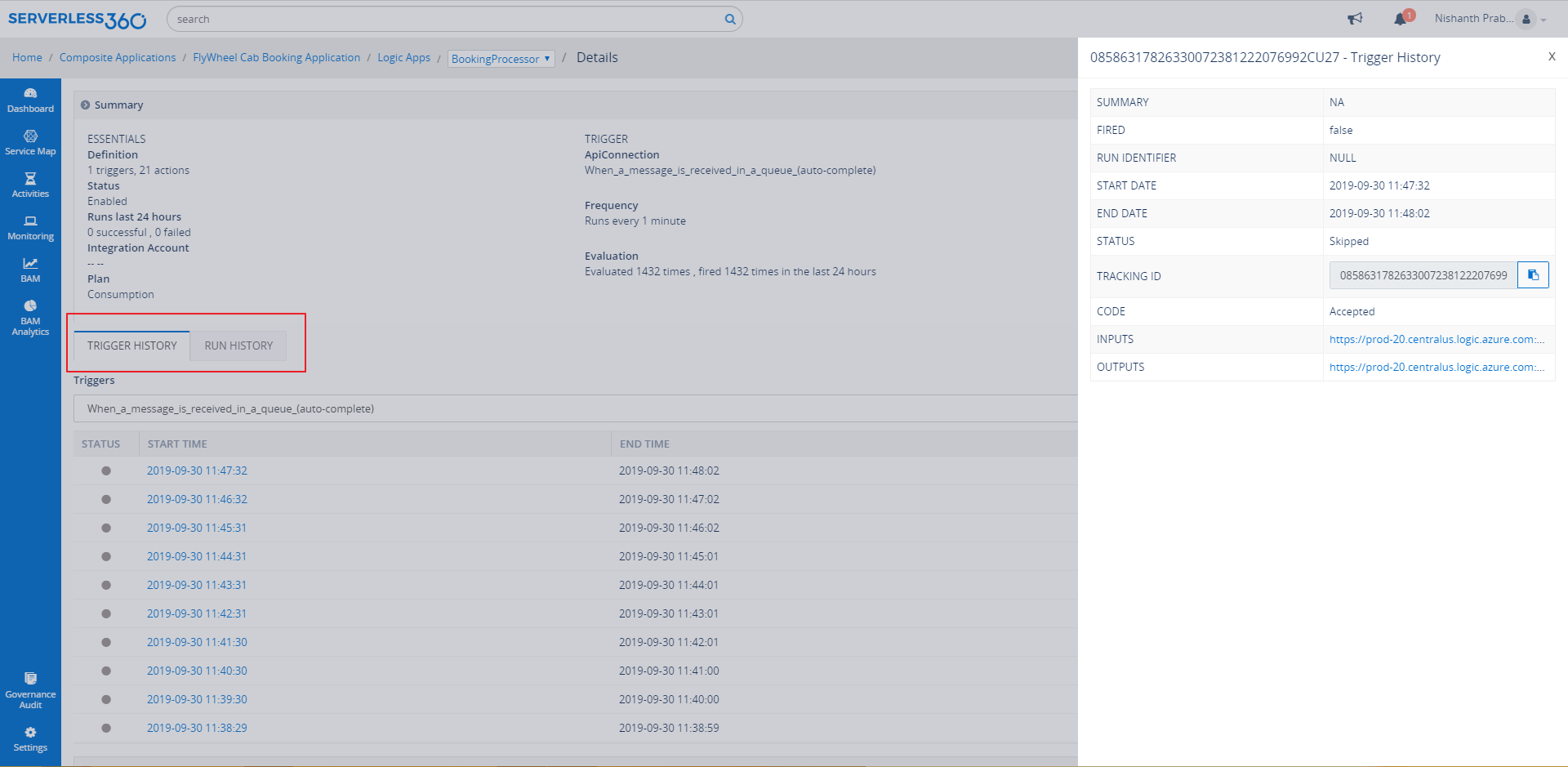
Search run histories
In Serverless360, User tin search the run history either by Identifier or with some time bound and condition. It is likewise possible to access the state of a Logic App run and Input/ Output bounds of the Run Actions. Fetching the failed run on a specific date and time and further looking into its input and output bound will be a key feature to have to support constructive debugging.
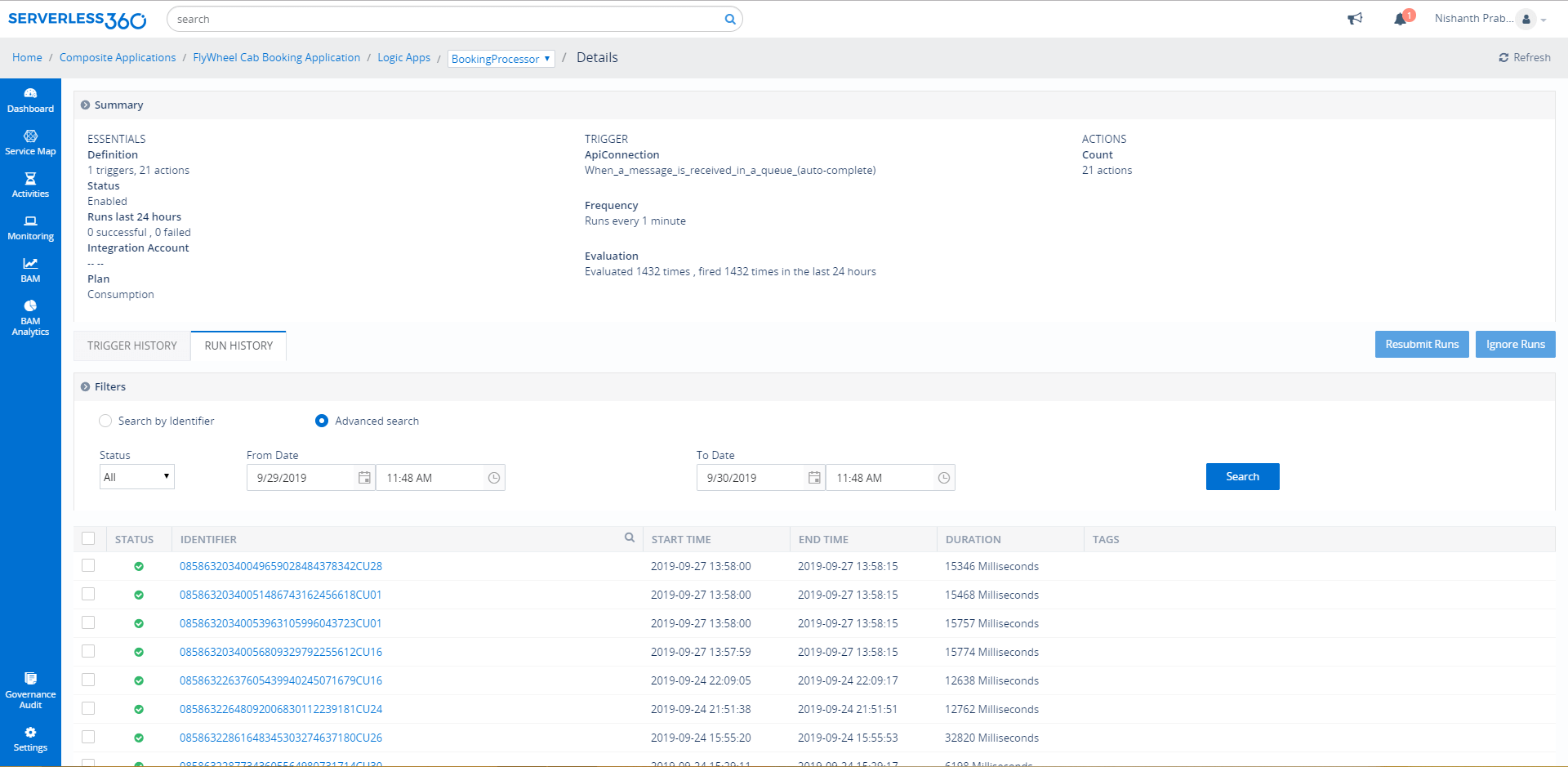
Resubmit runs
In that location would be a scenario like Logic App runs fail due to the incorrect configuration. After irresolute the Configuration, user would need to test Logic App with the same input. With Resubmission in Serverless360, user can resubmit the Logic App runs and attain correlation.
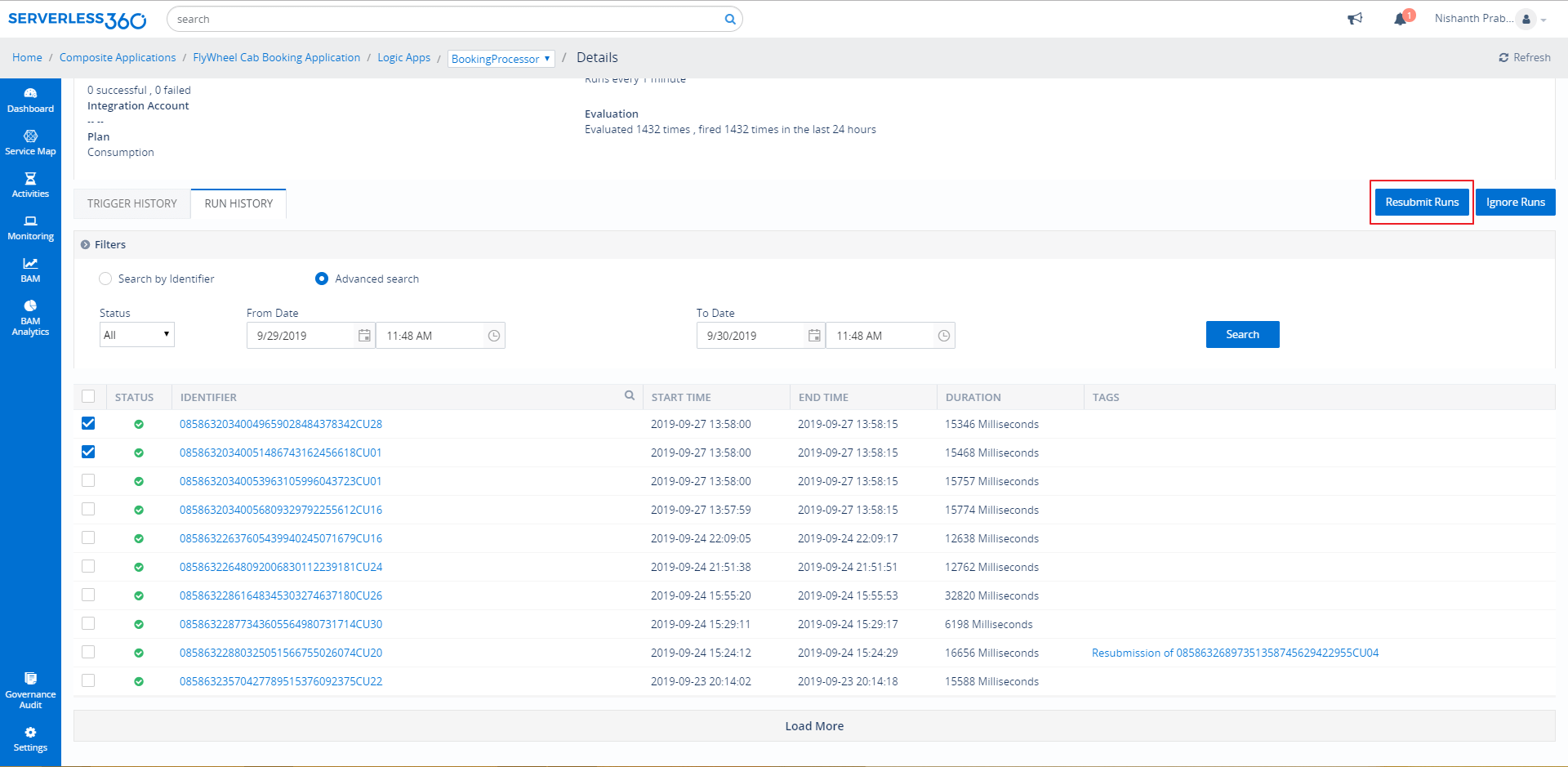
Correlate run resubmission
In Azure portal, user cannot achieve correlation betwixt resubmitted run and parent run merely in existent-world business scenario, user would need to achieve correlation when in that location are multiple run records which are interconnected. To overcome this challenge, Serverless360 offers the capability to achieve a correlation between the Resubmitted run and the Parent run. The Resubmitted run will be added with Tag with ID of the parent run and user tin investigate the status of the Parent run past clicking on that tag. It is also possible to add the Ignore tag with custom message to inform other users dealing with the Logic App not to do any operations.
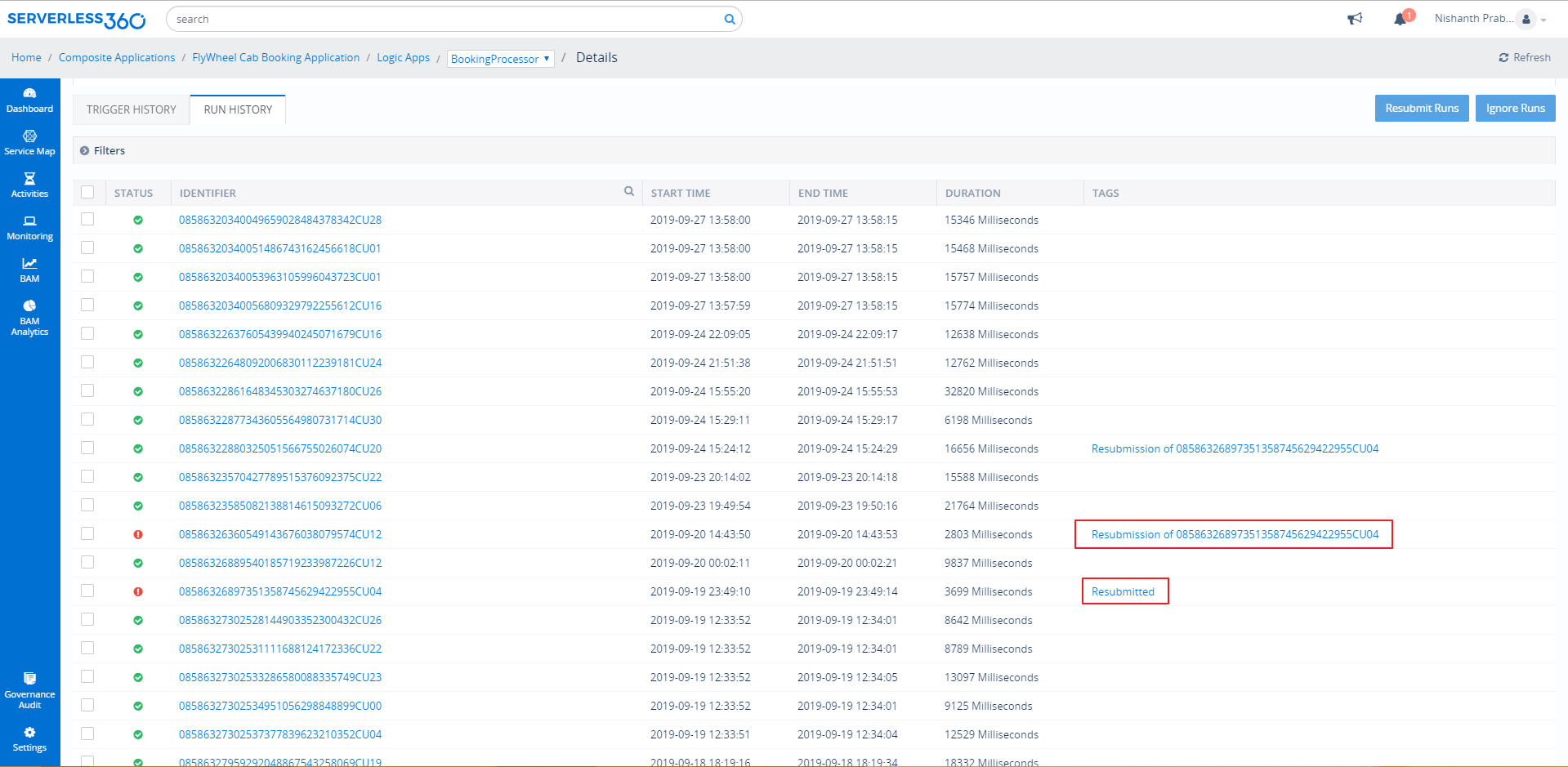
Service Map
Consider a Sales person would demand to visualize the orchestration and want to know the status of every entity involved in the orchestration. Here comes the Service Map in Serverless360 with which user can create the visual representation of the orchestration and get to view the condition of the entities involved in the orchestration as well. The Status of the entities is completely based on the Monitoring configuration done in the monitoring section.
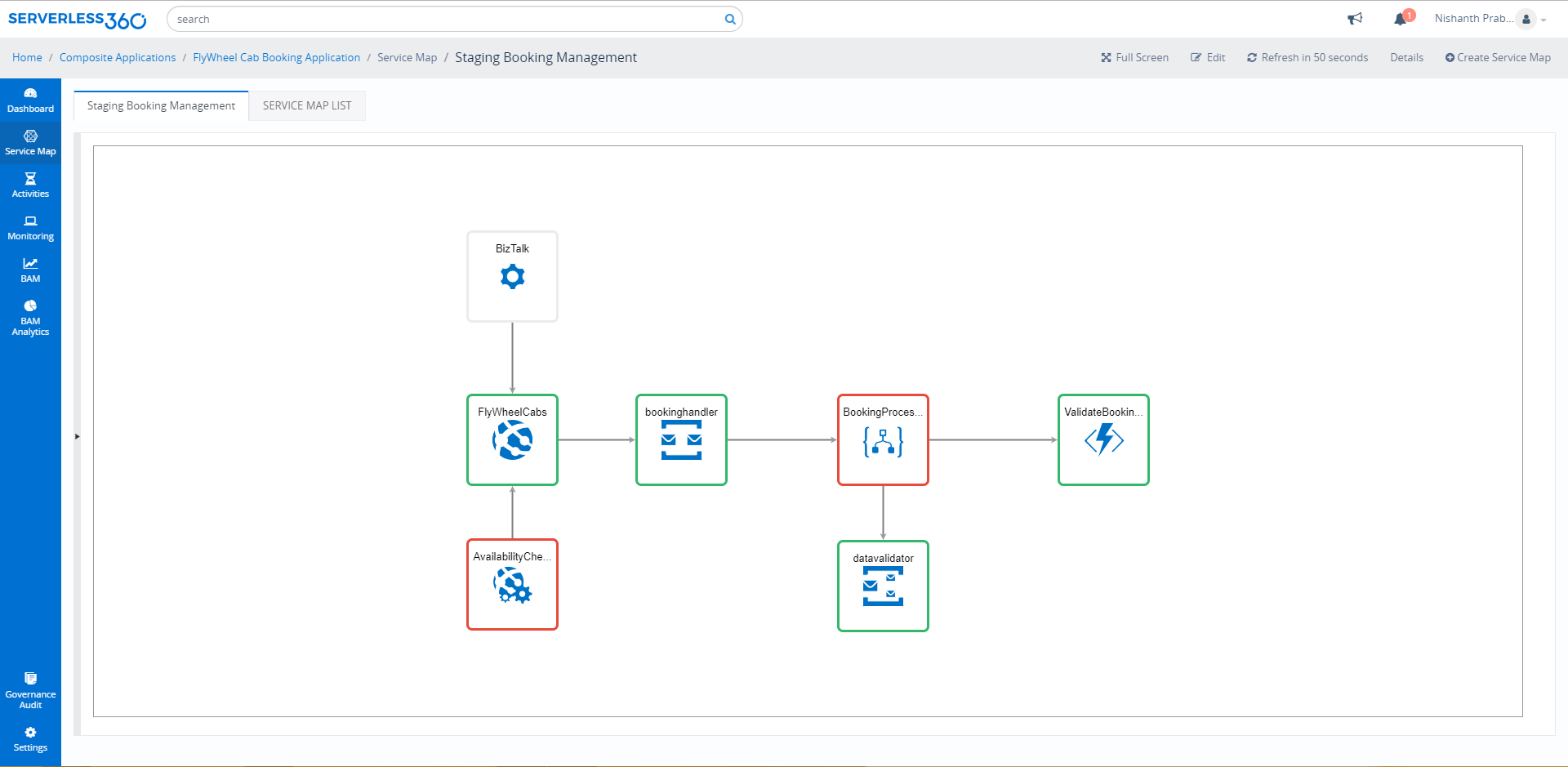
Next Steps:
- Search Logic Apps Run and Trigger History
- Azure Logic Apps better managed and monitored using Serverless360
Activities
With Activities in Serverless360, user can automate the complex and bulk processes for several entities.
Resubmit Failed runs
Consider the Fly bike Cab booking Awarding'southward cab booking scenario, where there were multiple failed bookings which need to be resubmitted to complete the transaction. With the Activeness in Serverless360, user can automate the resubmission of Failed Logic App runs along with Scheduling. It is possible to set the required context past calculation tag. Action can as well be configured to resubmit the failed runs of the selected trigger simply.
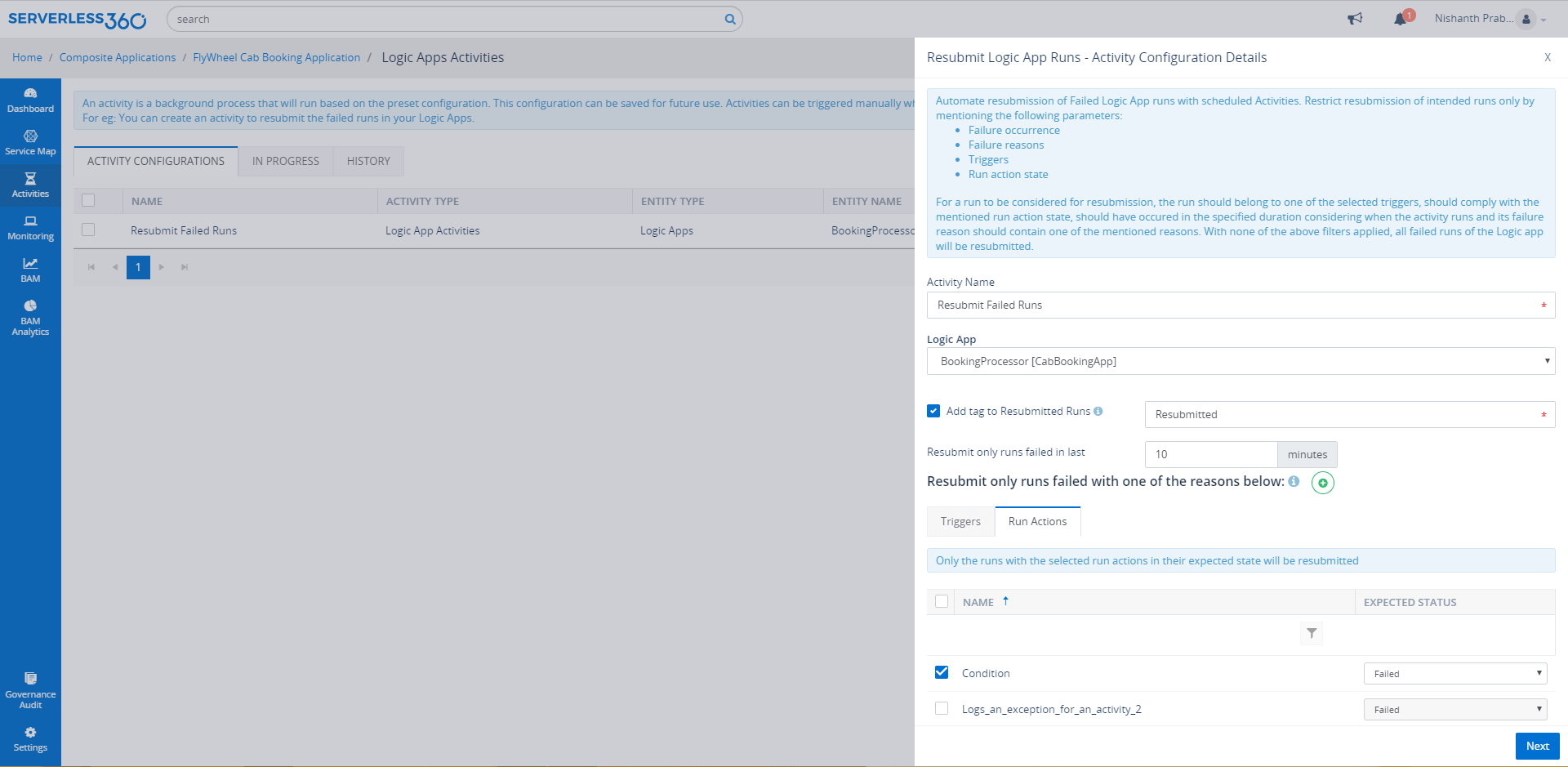
Business organization Activity Monitoring
Track the business organization process and message catamenia in the orchestration using Business Activeness Monitoring in Serverless360
Track Logic App with BAM
With BAM in Serverless360, user can perform end to terminate tracking of the message period through the business orchestration built using Azure Logic Apps. With the BAM connectors in Logic App, user can track the bulletin flowing through the stages and transactions of the Logic Apps in a Graphical view. With Exception logging, user can log the custom exception in the business concern procedure.
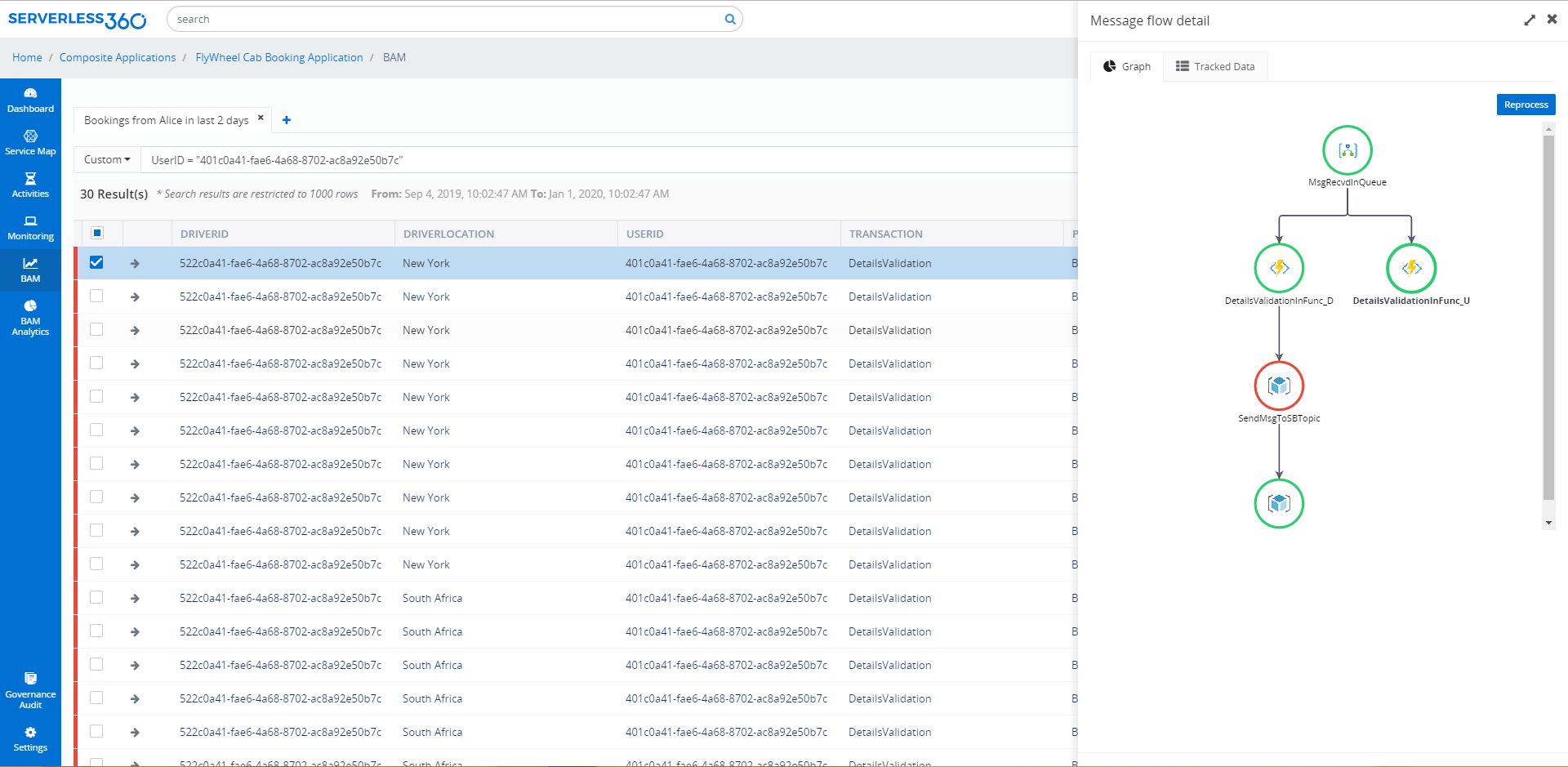
Information technology is also possible to reprocess the failed business organization procedure to restore the concern. Below is the good read on Business Activity Monitoring in Serverless360.
Side by side Steps:
- Finish to Cease Tracking with Business Activity Monitoring
Monitor Azure Logic App in Serverless360
At that place would exist a scenario like user would demand to get the status report of the entities for every ii hours or at the finish of the twenty-four hour period.
The Product managing director of the Cab Booking Application needs to know if the status of the Logic App is Enabled as expected. The need here is a consolidated report on status of all the entities those participate in the awarding at specified interval say every 4 hours in one case.
To run across this requirement, user can choose the Condition monitor in Serverless360. It monitors the entities based on their condition and basic properties. The consolidated written report can be received on the configured Notification Channels that Serverless360 supports.

Monitor metrics
The monitoring demand of an Architect of the Fly Wheel Cab Booking Application would be dissimilar. The Logic App should be monitored in multiple perspectives which would include performance, availability, consumption and so on.
Data monitor in Serverless360 is the all-time solution that can facilitate monitoring Logic Apps in various perspectives on the extensive set up of available Azure metrics. The metrics tin be selected based on the monitoring need. Delight refer the department 3.3 for quick reference on the available metrics and the monitoring perspective that can be achieved choosing the metric.

Violation Monitor
Consider a DevOps engineer of the Fly Bike Cab Booking Application, would demand to monitor the entities for any violation and needs to be informed every bit and when the violation occur, hither comes the Threshold monitor in Serverless360 to run across this demand. In a Threshold monitor, user will configure the violation persist time and number of alerts per violation while creating the monitor. If the violation exists beyond the violation persist fourth dimension, user volition get the alerts.
How to automatically monitor your Azure Logic App?
In Serverless360 user can configure the auto correct option on the entity status. Users tin configure the expected state and number of retries. Based on the configuration, monitor will automatically right the state of the entity. Serverless360 also automatically generates system monitoring profiles once y'all sign up for the tool. This feature reduces the fourth dimension taken to configure the monitoring profiles and is automatically available in the tool to monitor your resources.

Detect Failures
Consider a developer would need to detect whatever failure in Logic App trigger or run. With Watch monitor in Serverless360, developers tin detect the failure in trigger or run history of Logic Apps within the specified elapsing which can be as low as 5 mins. With Watch Monitor, User can also monitor based on Error reason of a Logic App run.
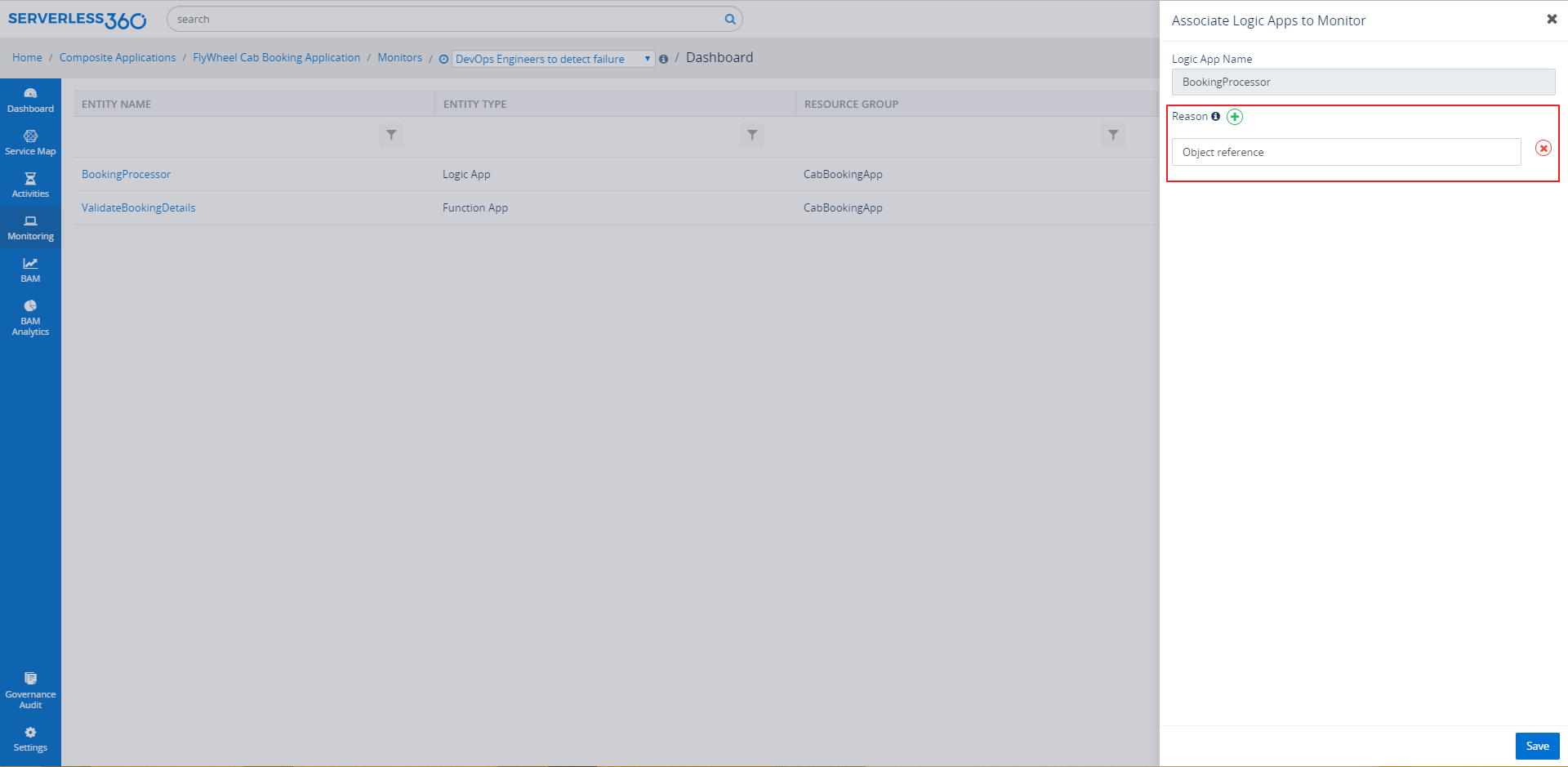
Side by side Steps:
- Azure Logic Apps Monitoring using Serverless360
- Azure Logic Apps meliorate managed and monitored using Serverless360
- Monitoring Azure Logic Apps using Serverless360 by Steef-Jan Wiggers
Webinar
This Webinar covers in detail the capabilities of Serverless360 to facilitate managing and monitoring Azure Logis Apps. All concepts are dealt with existent-world business use cases for better understanding.
This content will be continuously revamped to stay up to date.
How To Use Logic App To Connect To Web Service,
Source: https://www.serverless360.com/azure-logic-apps
Posted by: beckhamknestagave.blogspot.com


0 Response to "How To Use Logic App To Connect To Web Service"
Post a Comment